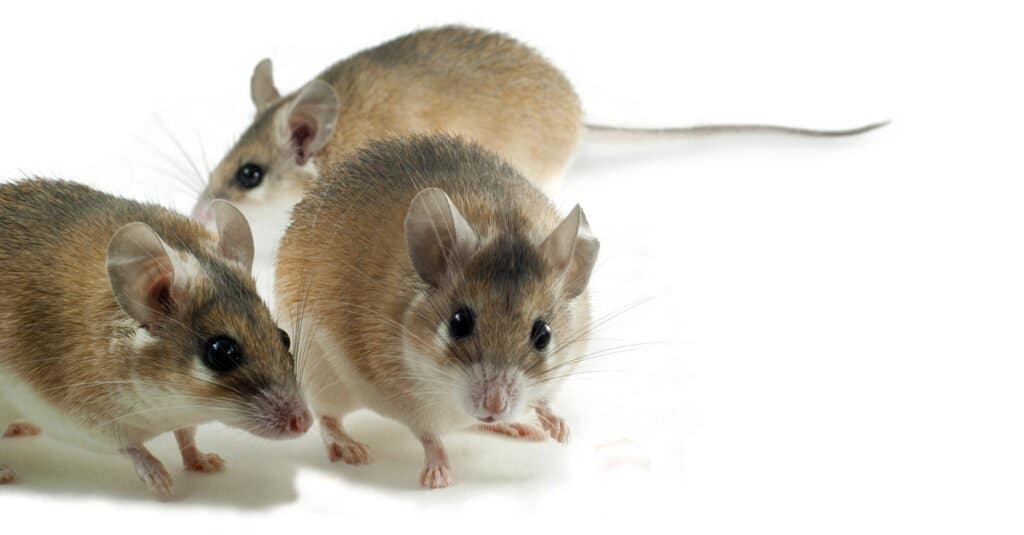Would you keep a rat as a pet? For some people, a rodent is an ideal companion. Some living in Rajasthan, India, take it even further. Here, rats are revered to the point that they even have their own temple. For other people, however, rats are nothing but pests. Any attempt to get rid of them begs the question: just how many rats are in the world?
From pet to pest, read on to find out why rats have made such an impact on human society.
How Many Rats Are in the World?

There are an estimated 7 billion rats in the world, nearly 1 rat for every human.
©Evgeny Haritonov/Shutterstock.com
There are an estimated 7 billion rats in the world. That’s almost 1 rat for every human. Though there are over 60 species of rats worldwide, homes, businesses, and sewers most commonly suffer from the brown or grey Norway rat.
Rats are perhaps most famous for being carriers of the Bubonic plague, or the Black Death, in the 14th century. Recent findings suggest that it was not the rats themselves that spread the plague but rather the fleas they carried. The plague was responsible for causing 25 million deaths between 1347 and 1351. This shocking death toll has given rats the infamy they have lived with ever since.
The Most Rat-Infested Place in the World

Chicago has long been ranked as the worst city in America for rats.
©Sean Pavone/Shutterstock.com
With millions of these rodents running around, Chicago has long been ranked as the worst city in America – and the world – for rats. Chicago is a crowded place, and rats tend to thrive where humans do, living off scraps and garbage. In fact, improper garbage disposal has been proposed as the reason for Chicago’s surplus of rats.
Other cities around the world experience this same problem. In the United States, the urban centers of Los Angeles, San Francisco, and New York rank high on the “rattiest cities” list. Elsewhere, London, England, and Paris, France, suffer their own infestations. China also struggles, with an estimated 2 billion rats in the country, most of them congregated in its major cities.
What Place in the World Has No Rats?

Alberta, Canada, claims the accomplishment of being rat-free.
©Alix Kreil/Shutterstock.com
Could there really be a place in the world with no rats? The answer is…sort of. One of Canada’s 10 provinces, Alberta, claims this prestigious accomplishment. Alberta sits in the western half of Canada between British Columbia and Saskatchewan. Since the 1950s, the provincial government has “waged war” on the rat population.
This extremely aggressive, almost militaristic campaign kept rat colonies in rural areas from spreading to urban centers. The poison of choice was Warfarin, advertised on multitudes of posters in public areas. In fact, it became a crime not to exterminate rats on sight.
Now, Alberta is known as the one non-polar region in the world with zero breeding rats. This means there may be a few rats running around, but they won’t be able to produce more. This effectively negates the population.
Of course, there is one other place in the world with no rats. Antarctica is too cold for most rodents to survive, making it the only continent with no rats whatsoever.
How Fast Can a Rat Population Grow?

A female rat gives birth to 5-12 pups per litter. She can have up to 6 litters in a year.
©SURAKIT SAWANGCHIT/Shutterstock.com
Rats are known as enthusiastic breeders. A female rat reaches sexual maturity in 8-12 weeks and can produce litters of 5-12 young rats, also called pups or kittens. A female can have as many as 6 litters a year. Taking into account the exponential growth possible in a rat colony, a single pair of rats could end up producing half a billion rats in just 3 years!
This astonishing figure highlights the importance of keeping rat populations under control. If not, they could easily explode to overwhelm their human cohabitants.
What Keeps the Rat Population in Check?
Without human intervention, the rat population would be far greater than it is now. Efforts to curb the growth of rat colonies in cities have been especially important. Both untrained individuals and professional exterminators may use traps and poison to get rid of rats in homes, businesses, and sewers.
Although rats are resistant to most diseases, illness can afflict them from various sources. Intestinal parasites like pinworms or tapeworms cause sickness or death; intestinal infections from protozoa may also be a problem. Chronic respiratory disease, as well as various viruses, have been known to harm or kill rodents. Needless to say, wild rats are far likelier to be exposed to these illnesses than captive rats.
Besides human intervention and diseases, rats also face several predators. Cats are notorious rat-hunters and are sometimes kept for this purpose. Snakes and birds of prey like hawks, owls, and falcons will eat rodents if the opportunity arises. Occasionally, rats even cannibalize each other.
Besides this, other environmental limitations like a lack of food or shelter may cause colony numbers to decrease.
The World’s Largest Rat

Sumatran bamboo rats are the largest rats in the world, with a body length of up to 20 inches and a maximum weight of 8.8 pounds.
©rweisswald/Shutterstock.com
Rats are typically 6-8 inches long in the body and weigh from 3-10 ounces, making them significantly larger than mice. However, some rats can grow even bigger than this. The largest breed of rat is the Sumatran bamboo rat. This rodent has a body length of up to 20 inches, not including an 8-inch tail, and can weigh as much as 8.8 pounds!
The Gambian pouched rat is smaller and lighter in body but longer from its nose to the tip of its tail at up to 35 inches.
Are Rats Dangerous?
Rats will bite if they feel threatened and have no means of escape. The bite itself can be painful, but the chance of infection is more serious. Rat-bite fever (RBF) commonly afflicts those bitten by rats carrying one of two types of bacteria: Streptobacillus moniliformis or Spirillum minus. Typical symptoms include fever, vomiting, rashes, headaches and muscle aches, and joint pain or swelling. Left untreated, it can prove fatal.
Rats are resistant to diseases in general, which means they are efficient carriers. Besides rat-bite fever, they may pass on other diseases, including hantavirus pulmonary syndrome, hemorrhagic fever, leptospirosis, and salmonellosis. Rat bites and water polluted by rat urine or droppings are the most common transmitters.
Surprisingly, rats make excellent pets if raised around humans. They are playful, affectionate, and easy to care for. Their innate intelligence enables them to learn new tricks. Most importantly, they rarely, if ever, bite.
As social animals, they need interaction regularly. A second rat is not necessary, but it may help with social stimulation. Just be sure they don’t breed, or you could be looking at a population explosion.
With stringent measures to control their population growth and keep them out of homes, rats are manageable pests. As pets, they can make endearing and loveable companions.
The photo featured at the top of this post is © chrisbrignell/Shutterstock.com
Thank you for reading! Have some feedback for us? Contact the AZ Animals editorial team.







